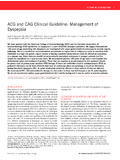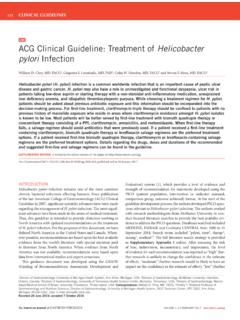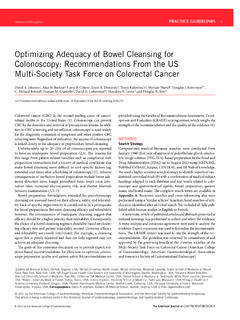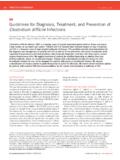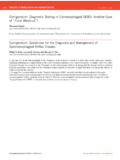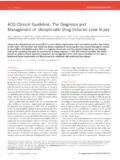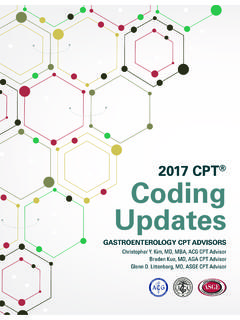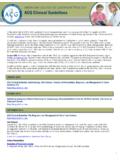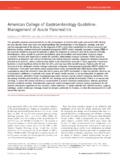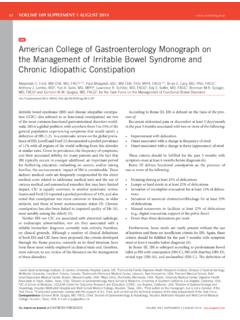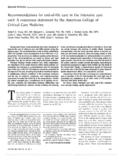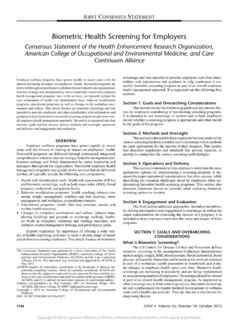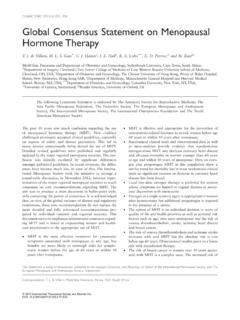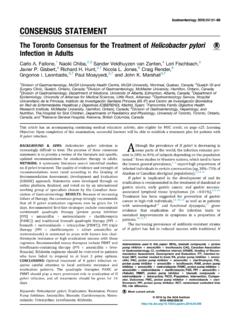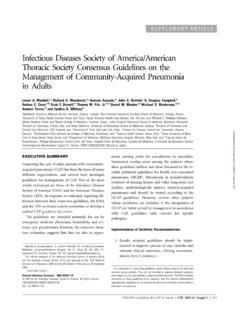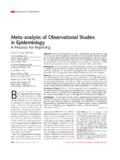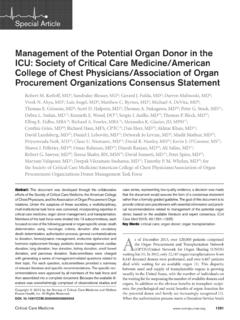Transcription of Guidelines on Genetic Evaluation and …
1 Nature publishing group PRACTICE Guidelines 1 2014 by the american College of Gastroenterology The american Journal of GASTROENTEROLOGYsee related editorial on page x Colorectal cancer (CRC) is a major american health problem that ranks as the second leading cause of cancer death aft er lung cancer. In the United States, approximately 143,000 new cases are diagnosed each year, and 51,000 Americans die annually from this disorder ( 1 ). Th e cause of CRC is multifactorial, with environment and inheritance playing varying roles in diff erent patients ( 2 ). Approxi-mately 70 80 % of patients with CRC seem to have sporadic dis-ease with no evidence of an inherited disorder.
2 In the remaining 20 30 % , a potentially defi nable inherited component might be causative ( 3 ). Lynch syndrome (LS), an autosomal dominant condition, is the most common cause of inherited CRC, accounting for about 3 % of newly diagnosed cases of colorectal malignancy ( 4 8 ). Th e eponym Lynch syndrome recognizes Dr Henry T. Lynch, the fi rst author on the original 1966 publication that comprehen-sively described this condition ( 9 ). In the early 1990s, mutation of genes in the DNA mismatch repair (MMR) pathway were implicated as the cause of LS ( 10 13 ), and the presence of the mutations now defi nes the syndrome.
3 Since then, germline testing with increasing sensitivity has been available for patients, as additional Genetic discoveries have occurred. When used appropriately, Genetic testing for LS can confi rm the diagnosis at the molecular level, justify surveillance of at-risk persons, decrease the cost of surveillance by risk strati-fi cation, aid in surgical and chemoprevention management, and help in decisions concerning family and career planning. How-ever, when used inappropriately, Genetic testing can misinform aff ected patients with false-negative results and waste patient and societal resources. Th e goal of this consensus document is to critically analyze the current literature and provide best practice evidence-based recommendations for diagnosis and management strategies to health care providers caring for these patients.
4 Guidelines on Genetic Evaluation and Management of Lynch Syndrome: A Consensus Statement by the US Multi-Society Task Force on Colorectal Cancer Francis M. Giardiello , MD 1 , John I. Allen 2 , Jennifer E. Axilbund 1 , C. Richard Boland 3 , Carol A. Burke 4 , Randall W. Burt 5 , James M. Church 4 , Jason A. Dominitz 6 , 7 , David A. Johnson 8 , Tonya Kaltenbach 9 , Theodore R. Levin 10 , David A. Lieberman 11 , Douglas J. Robertson 12 , 13 , Sapna Syngal 14 16 and Douglas K.
5 Rex 17 The Multi-Society Task Force, in collaboration with invited experts, developed Guidelines to assist health care providers with the appropriate provision of Genetic testing and management of patients at risk for and affected with Lynch syndrome as follows: Figure 1 provides a colorectal cancer risk assessment tool to screen individuals in the offi ce or endoscopy setting; Figure 2 illustrates a strategy for universal screening for Lynch syndrome by tumor testing of patients diagnosed with colorectal cancer; Figures 3 6 provide algorithms for Genetic Evaluation of affected and at-risk family members of pedigrees with Lynch syndrome; Table 10 provides Guidelines for screening at-risk and affected persons with Lynch syndrome; and Table 12 lists the Guidelines for the management of patients with Lynch syndrome.
6 A detailed explanation of Lynch syndrome and the methodology utilized to derive these Guidelines , as well as an explanation of, and supporting literature for, these Guidelines are provided. Am J Gastroenterol advance online publication, 29 July 2014; doi: 1 Johns Hopkins University School of Medicine , Baltimore , Maryland , USA ; 2 Yale University School of Medicine , New Haven , Connecticut , USA ; 3 Baylor University Medical Center , Dallas , Texas , USA ; 4 Cleveland Clinic , Cleveland , Ohio , USA ; 5 University of Utah , Salt Lake City , Utah , USA ; 6 VA Puget Sound Health Care System , Seattle , Washington , USA ; 7 University of Washington , Seattle , Washington , USA ; 8 Eastern Virginia Medical School , Norfolk , Virginia , USA.
7 9 Stanford University , Palo Alto , California , USA ; 10 Kaiser Permanente Medical Center , Walnut Creek , California , USA ; 11 Oregon Health and Science University , Portland , Oregon , USA ; 12 White River Junction VA Medical Center , White River Junction , Vermont , USA ; 13 Geisel School of Medicine at Dartmouth , White River Junction , Vermont , USA ; 14 Brigham and Women s Hospital , Boston , Massachusetts , USA ; 15 Dana Farber Cancer Institute , Boston , Massachusetts , USA ; 16 Harvard Medical School , Boston , Massachusetts , USA ; 17 Indiana University School of Medicine , Indianapolis , Indiana , USA.
8 Correspondence: Francis M. Giardiello, MD , 1830 East Monument Street, Room 431, Baltimore , Maryland 21205 , USA . E-mail: 2014 by the american College of Gastroenterology, american Gastroenterological Association, the american Society of Colon and Rectal Surgeons, and the american Society for Gastrointestinal Endoscopy. This article is being published jointly in the american Journal of Gastroenterology , Gastroenterology , Diseases of the Colon & Rectum , and Gastrointestinal Endoscopy . The american Journal of GASTROENTEROLOGY VOLUME 104 | XXX 2014 Giardiello et al. METHODOLOGY Literature review A systematic computer-aided search of MEDLINE from 2005 to 2012 was performed focusing on LS, hereditary nonpolyposis colorectal cancer (HNPCC), and associated reports of Genetic testing.
9 Th e search identifi ed all literature under the medical sub-ject headings and text words, hereditary nonpolyposis colorectal cancer, HNPCC, Lynch syndrome, Muir Torre syndrome, Turcot syndrome, and gene / Genetic testing. In addition, a search was conducted using references from all retrieved reports, review articles, and textbook chapters. Publications were retrieved, and the authors synthesized and assessed the quality of the available data with respect to topicality and timeliness. Diff erences among reviewers concerning inclusions were resolved by consensus. Edito-rials and letters to the editors were excluded from this review.
10 Levels of evidence A variety of diff erent types of publications were reviewed, includ-ing randomized controlled trials, retrospective and prospective observational cohorts, and population-based and case-control studies. Th e strength of the evidence from these sources was rated according to the National Cancer Institute levels of evidence for cancer Genetic studies ( Table 1 ) ( 14 ). In addition, a well-accepted rating of evidence, Grades of Recom-mendation, Assessment, Development, and Evaluation (GRADE), which relies on expert consensus about whether new research is likely to change the confi dence level (CL) of the recommendation was also utilized for Evaluation of LS interventions ( Ta b l e 2 ) ( 15 ).
